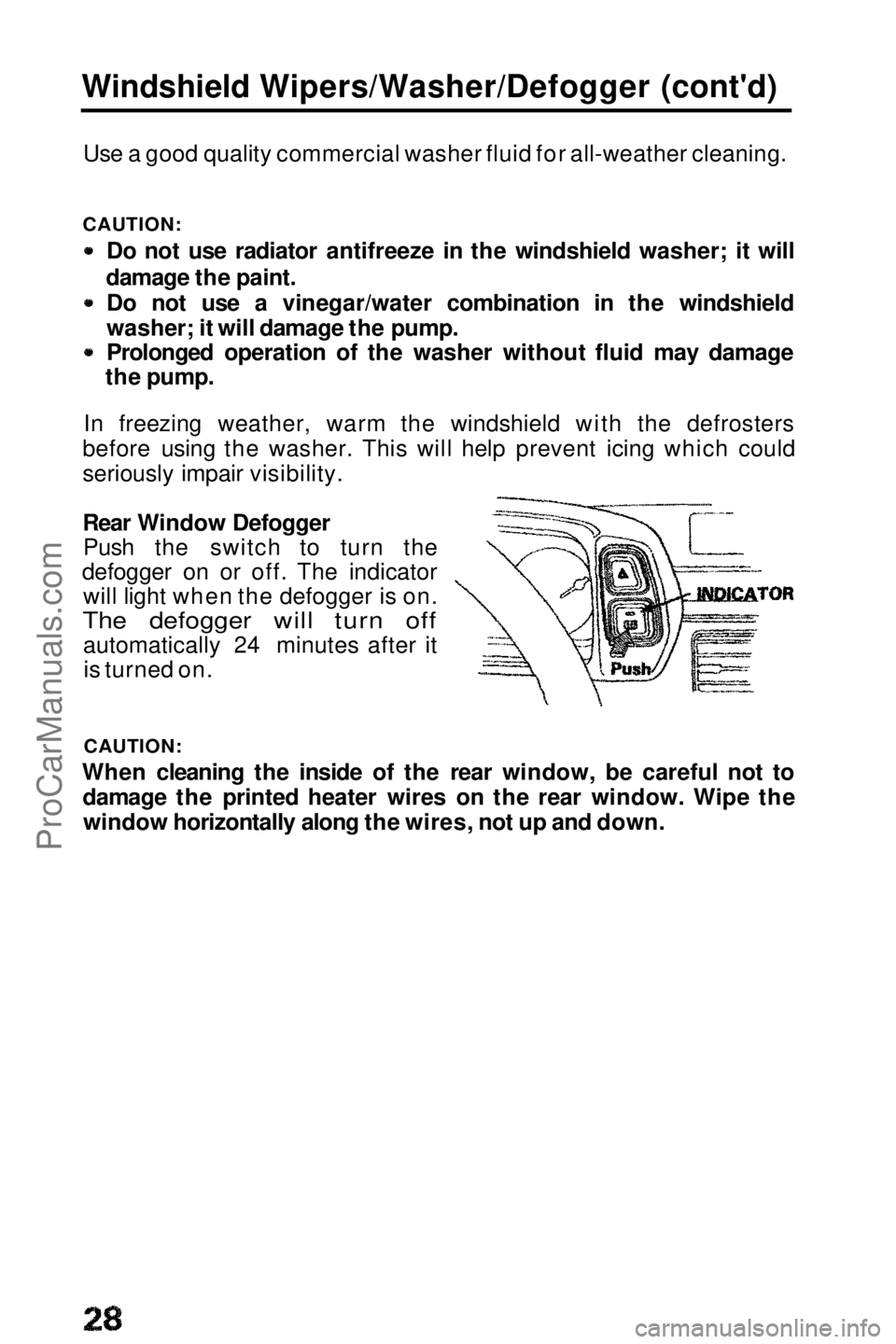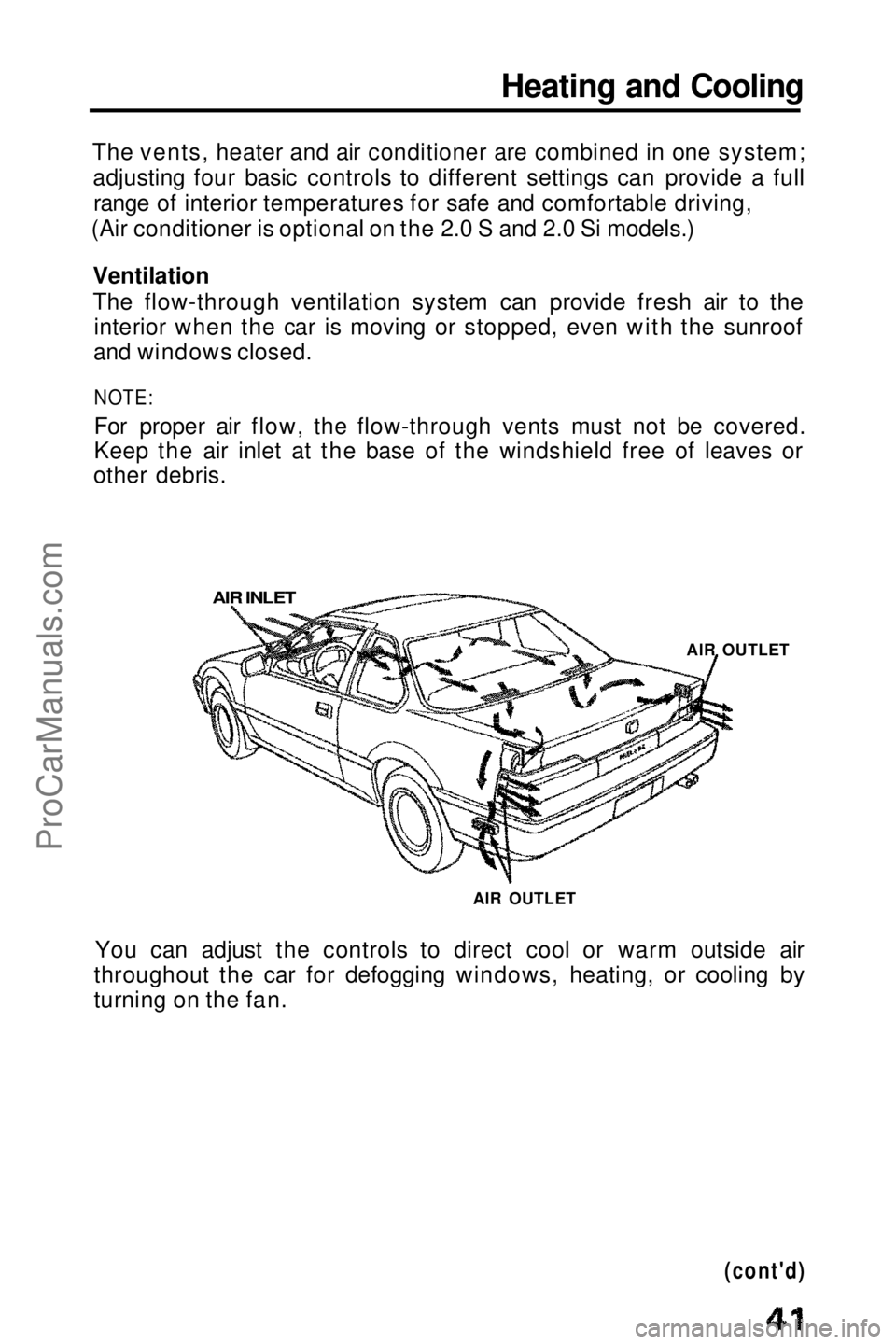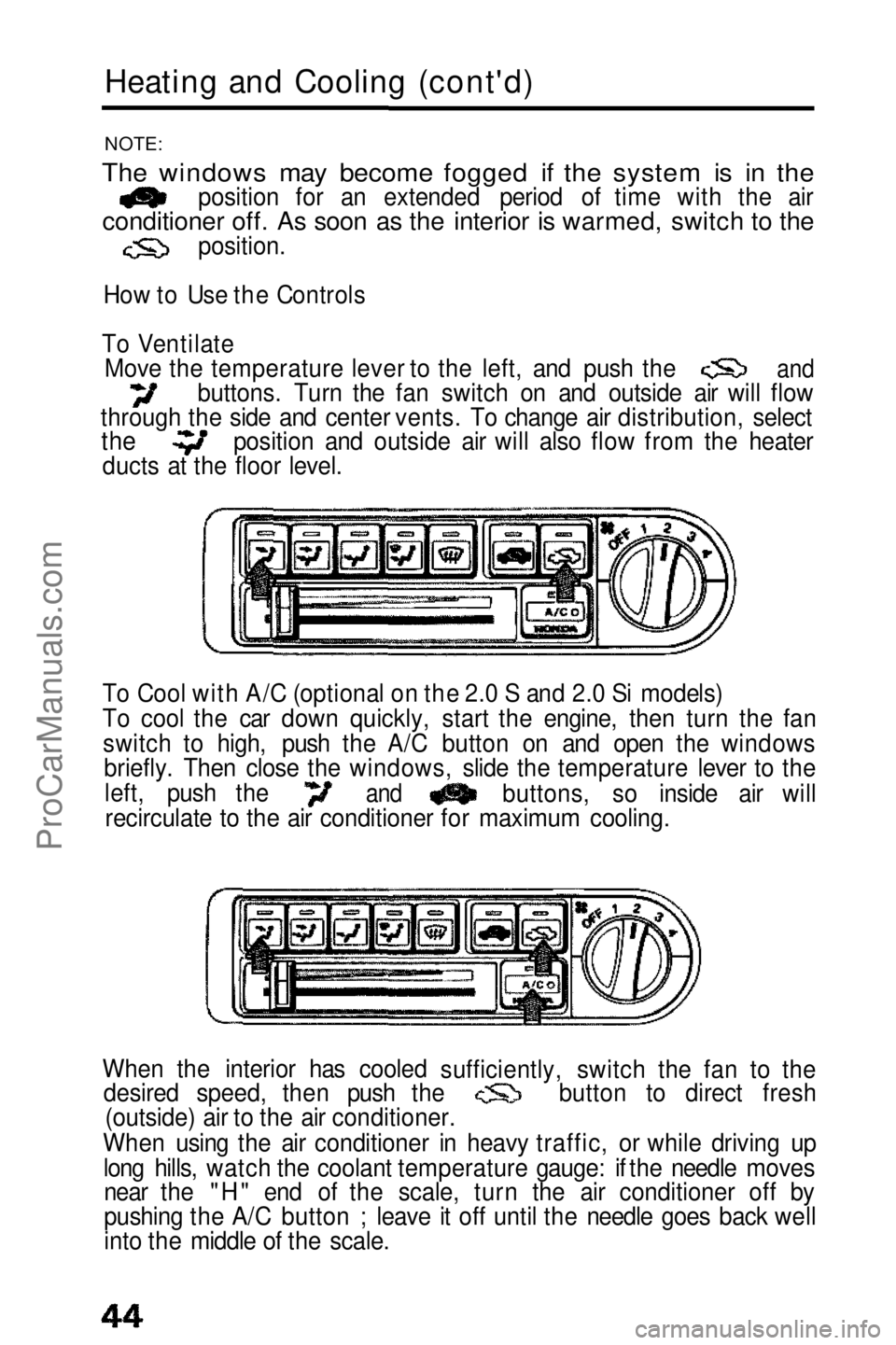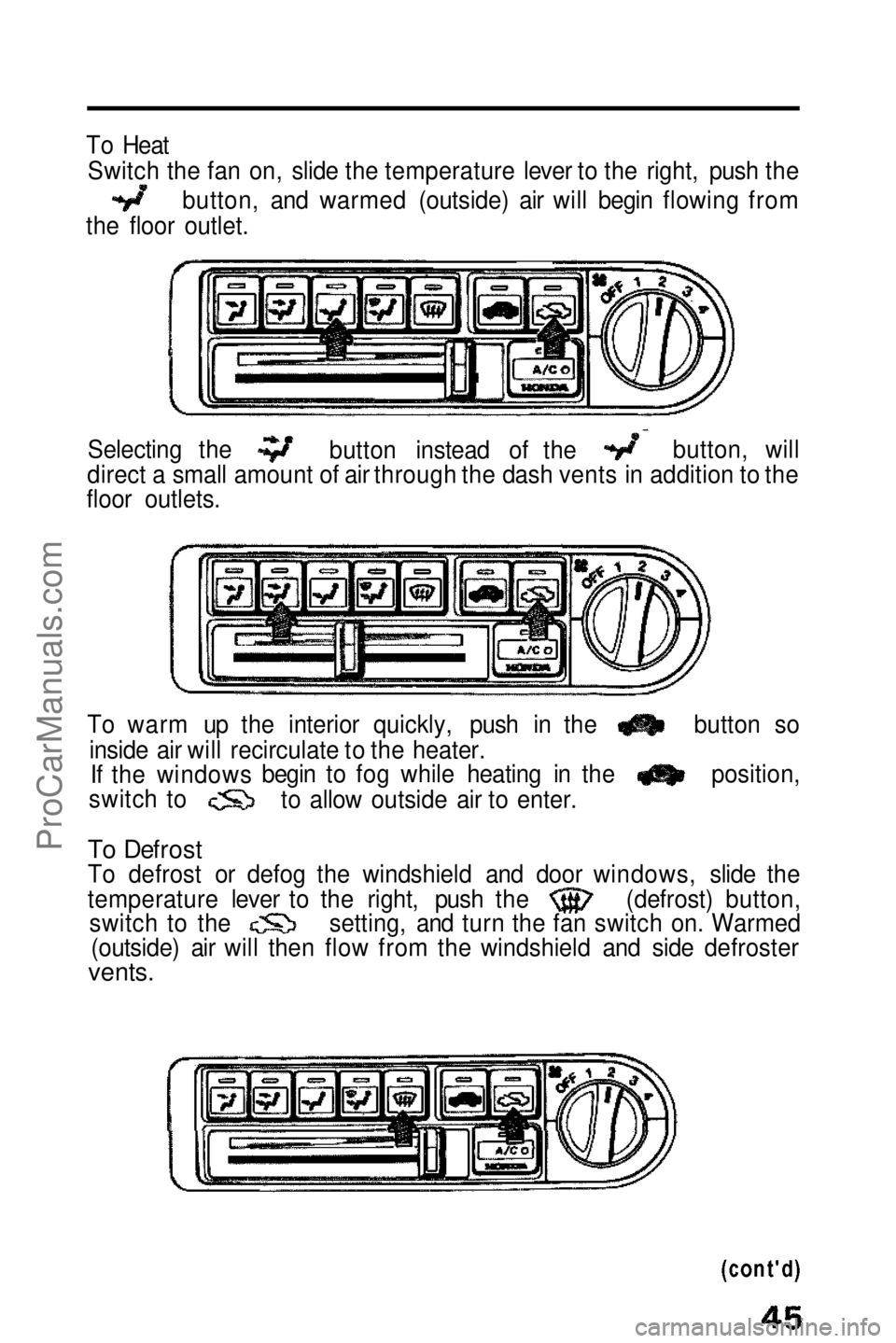1990 HONDA PRELUDE heater
[x] Cancel search: heaterPage 28 of 143

Windshield Wipers/Washer/Defogger (cont'd)
CAUTION:
Do not use radiator antifreeze in the windshield washer; it will
damage the paint. Do not use a vinegar/water combination in the windshield
washer; it will damage the pump.
Prolonged operation of the washer without fluid may damage
the pump.
In freezing weather, warm the windshield with the defrosters
before using the washer. This will help prevent icing which could
seriously impair visibility.
Rear Window Defogger Push the switch to turn the
defogger on or off. The indicator will light when the defogger is on.
The defogger will turn off
automatically 24 minutes after itis turned on.
CAUTION:
When cleaning the inside of the rear window, be careful not to damage the printed heater wires on the rear window. Wipe thewindow horizontally along the wires, not up and down. Use a good quality commercial washer fluid for all-weather cleaning.ProCarManuals.comMain Menu s t
Page 41 of 143

Heating and Cooling
The vents, heater and air conditioner are combined in one system; adjusting four basic controls to different settings can provide a fullrange of interior temperatures for safe and comfortable driving,
(Air conditioner is optional on the 2.0 S and 2.0 Si models.)
Ventilation
The flow-through ventilation system can provide fresh air to theinterior when the car is moving or stopped, even with the sunroof
and windows closed.
NOTE:
For proper air flow, the flow-through vents must not be covered.
Keep the air inlet at the base of the windshield free of leaves or
other debris.
You can adjust the controls to direct cool or warm outside air
throughout the car for defogging windows, heating, or cooling by
turning on the fan.
(cont'd)
AIR INLET
AIR OUTLET
AIR OUTLETProCarManuals.comMain Menu t s
Page 43 of 143

What the Controls Do:
FUNCTION BUTTONS
AND INDICATOR LIGHTS RECIRCULATION BUTTON
AND INDICATOR LIGHT FRESH AIR BUTTON
AND INDICATOR LIGHT
FAN SWITCH
TEMPERATURE LEVER AIR CONDITIONER SWITCH
AND INDICATOR LIGHT COMPRESSOR LIGHT
Fan Switch
Turning the dial clockwise will increase the fan speed, and the fan
will circulate warm, cool, or outside air, depending on where the
temperature lever and function buttons are set.
Function Buttons
Push the appropriate button to direct air to and from the heater,
defroster and vents. Each function button has an indicator light that
comes on when the button is pushed in.
Air Conditioner Switch (optional on the 2.0 S and 2.0 Si models)
With the fan on, push the A/C switch to operate the air conditioner;
the indicator light will come on.
Push the switch again to turn the air conditioner off.
NOTE:
If the air conditioner compressor light comes on, turn off the A/C
switch (with the engine running) and turn it on again. If the light does
not come on again, the system is functioning normally, if the light
does come on again, turn off the A/C switch and do not use the
system until it can be checked by an authorized Honda dealer.
Temperature Lever Slide the lever from left to right to make air warmer when the
appropriate function is selected. and Recirculation
Fresh Air
When the
Buttons
button is pushed, the indicator light will go on and
outside air will be allowed to circulate inside the car.
When the outside air is shut off, and the air inside the car is recirculated. So,
when the heater or air conditioner is on and you want to warm up
or cool down the interior more quickly, or keep smoke or dust out
of the car without losing the heat or cool function, simply push the
button.
button is pushed, the indicator light comes on,ProCarManuals.comMain Menu t s
Page 44 of 143

Heating and Cooling (cont'd)
NOTE:
The windows may become fogged if the system is in the
position for an extended period of time with the air
conditioner off. As soon as the interior is warmed, switch to the
position.
How to Use the Controls
To Ventilate Move the temperature lever to the left, and push the buttons. Turn the fan switch on and outside air will flow
through the side and center vents. To change air distribution, select
To Cool with A/C (optional on the 2.0 S and 2.0 Si models)
To cool the car down quickly, start the engine, then turn the fanswitch to high, push the A/C button on and open the windows briefly. Then close the windows, slide the temperature lever to the
When the interior has cooled desired speed, then push the (outside) air to the air conditioner.
When using the air conditioner in heavy traffic, or while driving up long hills, watch the coolant temperature gauge: if the needle movesnear the "H" end of the scale, turn the air conditioner off by
pushing the A/C button ; leave it off until the needle goes back well
into the middle of the scale.
and
the
ducts at the floor level. position and outside air will also flow from the heater
sufficiently, switch the fan to thebutton to direct fresh
and
left, push the
recirculate to the buttons, so inside air will
air conditioner for maximum cooling.ProCarManuals.comMain Menu t s
Page 45 of 143

To Heat
Switch the fan on, slide the temperature lever to the right, push the
button, and warmed (outside) air will begin flowing from
the floor outlet.
Selecting the
direct a small amount of air through the dash vents in addition to the
floor outlets. button, will
button instead of the
To warm up the interior quickly, push in the inside air will recirculate to the heater. button so
position,
begin to fog while heating in the
to allow outside air to enter.
If the windows
switch to
To Defrost
To defrost or defog the windshield and
temperature lever to the right, push the door windows, slide the
(defrost) button,
switch on. Warmed
(outside) air will then flow from the windshield and side defroster
vents.
switch to the
setting, and turn the fanProCarManuals.comMain Menu t s
Page 90 of 143

Cooling System (cont'd)
Thermostat The thermostat in the cooling system does not need to be changedfor summer or winter operation. However, for extremely cold
climates, an optional thermostat is available from your Honda dealer.
Replacing CoolantReplace coolant at 36 months or 45,000 miles (72,000 km),
whichever comes first. Thereafter, replace every 2 years or 30,000
miles (48,000 km), whichever comes first.
RADIATOR COOLANT
REFILL CAPACITY:
including reserve tank 0.75 l (0.198 US gal, 0.165 Imp gal)
Manual transmission 2.0 S: 5.15 l (1.361 US gal, 1.133 Imp gal)
2.0 Si,Si: 6.15 l (1.625 US gal, 1.353 Imp gal)
Automatic transmission 2.0S:5.85 l (1.546 US gal, 1.287 Imp gal)
2.0 Si,Si: 6.15 l (1.625 US gal, 1.353 Imp gal)
1. Set the heater temperature lever to maximum heat.
2. Remove the radiator cap and loosen the drain plug when the radiator is cool, and drain the radiator.
RADIATOR
CAP BLEED BOLT
DRAIN BOLT
3. Remove the drain bolt from the front side of the cylinder block, and drain the engine and heater.
4. Apply non-hardening sealant to the drain bolt threads, then reinstall the bolt and tighten it securely.
5. Tighten the radiator drain plug securely.
DRAIN
PLUGProCarManuals.comMain Menu t s
Page 119 of 143

Jump Starting
To start a car with a dead battery, use another battery of the same voltage, and the proper jumper cables. Procedures other than those below could cause injury or
damage from battery acid spray, explosion or charging system
overload.
Never connect the jumper cable directly to the negative post of
the "dead" battery.
Never allow the two cars to touch each other.
Never allow the jumper cable clamps to touch each other.
Never lean over the battery when making connections.
Never attempt to jump start a vehicle with a frozen battery. The
battery could rupture and explode. If you suspect a frozen
battery, remove the vent caps and check the fluid. If there
seems to be no fluid, or if you see ice, do not attempt a jump
start until the fluid thaws.
CAUTION:
If jumper cables are connected backwards, the car's main fuse
may blow.
1.Turn off all lights, heater and other electrical loads, set parking
brake, and
shift transmission to Neutral or Park.
2. Use one cable to connect the positive terminal of the booster battery to the positive terminal of the "dead" battery.
(cont'd)
Do not attach cable here
DEAD BATTERY
Positive to positive
Negative to the engine, not to the battery
BOOSTER BATTERYProCarManuals.comMain Menu t s